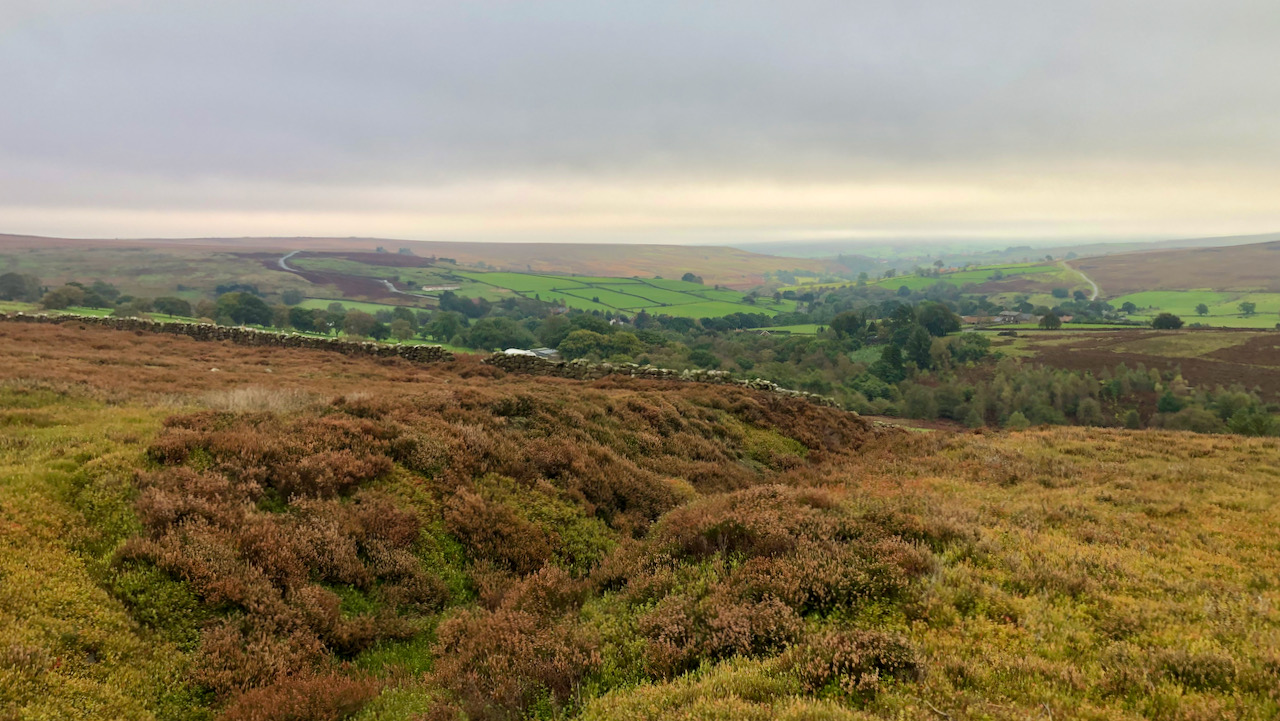This morning I awoke to find a reminder in my calendar. It told me that on this very day back in 1536, King Henry VIII got tough on the Pilgrimage of Grace rebels. Now, naturally, I pondered where I could saunter off to today that might have a smidgen of relevance to that dusty tidbit. My choice landed on Skelderskew Moor, up above Commondale.
With the clouds base at about 300 metres and descending faster than the dignity of a Tory politician, I managed to reach the crest of the moor, which provided a grand view of Skeldersceugh Farm. Out of the murk emerged three beaters with a motley crew of dogs. I braced for a showdown, but they didn’t give me the time of day. Apparently, a septuagenarian rambling about the moors alone was nothing to fuss about. I inquired of the most seasoned gent, based on his demeanour and attire, where they were shooting. He half-heartedly gestured toward Hob on the Hill and went on, flag in hand, stomping through the moor with purpose.
Now, I’m no expert in the fine art of grouse shooting, but I’d reckon those gamekeepers and their lackeys should be duty-bound to inform the public about areas where they might get pelted with flying objects.
But let’s not veer off course. The Pilgrimage of Grace was a major rebellion kicked off by the release of a new law to shut down minor religious houses in the merry month of March, 1536. Those rebels styled themselves as pilgrims, marching under banners adorned with the five wounds of Christ. But from the beginning, they mixed their holy fervour with grumbles about the economy and politics.
After the Pilgrimage of Grace, old Henry made some promises he had no intention of keeping, which kept the grumbling going. Come October 1536, the Lincolnshire Rising set off a broader rebellion, triggered by fears of new taxes and the government confiscating folks’ property. Thomas Cromwell, the king’s chancellor, was the bloke taking the heat for these shenanigans.
So, on this day in 1536, the King had had enough of this nonsense and ordered the apprehension of the ringleaders, with an option to pop them off as traitors right there or parade them in front of him. Monks, well, they were to be hanged without delay in their monks’ apparel.
In January 1537, dissent continued with Bigod’s Rebellion, spearheaded by Sir Francis Bigod, a bigwig from the East Riding of Yorkshire. His cunning plan to seize Scarborough Castle utterly failed. Then, a few days later, his attack on Kingston upon Hull was foiled when the majority of his followers were rounded up in a covert raid at the crack of dawn in Beverley. He managed to slip away to Mulgrave and then skedaddled to Cumberland. However, his luck ran out in the following month, when he was apprehended and confined to the grim walls of Carlisle Castle.
Now, Skeldersceugh Farm was once a grange attached to Guisborough Priory, looked after by Nicholas Cockerell, brother of James Cockerell, the former Prior of Guisborough1‘Parishes: Guisborough | British History Online’. 2023. British-History.ac.uk <https://www.british-history.ac.uk/vch/yorks/north/vol2/pp352-365#p25> [accessed 19 October 2023]. Seems like Nicholas ran into a spot of trouble during Bigod’s uprising, because he wasn’t keen on joining the rebels alongside his brother. According to a deposition signed by Cromwell2‘Henry VIII: April 1537, 16-20 | British History Online’. 2023. British-History.ac.uk <https://www.british-history.ac.uk/letters-papers-hen8/vol12/no1/pp433-447#:~:text=The%20commons%20took,by%20Cromwell.> [accessed 19 October 2023]:
“The Commons [rebels] took his brother Nicholas at his house in Skelderscugh and threatened and held and beat him with their daggers’ pommels, when they took from him 5£. in money, seven silver spoons, a little flat piece of silver, 3 pairs of beads with silver gawdies, 20 head of cattle, oxen and kye and 3 horses, all because he refused to join them. His debts amounted to 96£. 13s. 4d. and the monastery owes him 350£ or thereabouts.”
The dissolution of Guisborough Priory had begun earlier in 1536 when the King’s Commissioners arrived at Guisborough. They strong-armed James Cockerell, into resigning as Prior, and they installed Robert Pursglove in his stead. This wasn’t a popular move, given that Cockerell had quite the local support, with around 500 households in town relying on the Priory for their bread and butter3GPP. 2021. ‘900 Years of History – Gisborough Priory Project’, Gisborough Priory Project – Explore Gisborough Priory & Woodland Gardens <https://gisboroughprioryproject.org.uk/900-years-of-history/> [accessed 19 October 2023].
Come 25th May, 1537, in the aftermath of Bigod’s Rebellion, James Cockerell along with Bigod were among the unfortunate rebels who got the full grisly treatment: hung, drawn, and quartered, with their heads decorating London Bridge and other gates in the city.
And the photo above, it’s taken right on the edge of a medieval deer park4NYM NP HER No: 4033. That’s the ditch with an outer bank. The fields of Skeldersceugh Farm lie beyond the moor wall, with the actual farmhouse tucked away on the far left.
- 1‘Parishes: Guisborough | British History Online’. 2023. British-History.ac.uk <https://www.british-history.ac.uk/vch/yorks/north/vol2/pp352-365#p25> [accessed 19 October 2023]
- 2‘Henry VIII: April 1537, 16-20 | British History Online’. 2023. British-History.ac.uk <https://www.british-history.ac.uk/letters-papers-hen8/vol12/no1/pp433-447#:~:text=The%20commons%20took,by%20Cromwell.> [accessed 19 October 2023]
- 3GPP. 2021. ‘900 Years of History – Gisborough Priory Project’, Gisborough Priory Project – Explore Gisborough Priory & Woodland Gardens <https://gisboroughprioryproject.org.uk/900-years-of-history/> [accessed 19 October 2023]
- 4NYM NP HER No: 4033

Leave a Reply